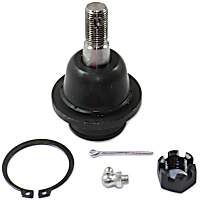A strut mount is one of the lesser-known parts of a vehicle’s suspension system. Small, flat, and unremarkable, it is easily overshadowed by other components with a more active role in the suspension, like shock absorbers and struts. (For a technical understanding of different configurations of strut suspensions, you can read our discussion here.)
Although this component is often overlooked, the suspension system can’t function properly without it. A damaged strut mount can cause strange noises, poor handling, and overall ride discomfort.
Do you think your car may have a bad strut mount? If it exhibits one or more of the symptoms below, you may be right.

Signs of a Bad Strut Mount
A strut mount is a part of the vehicle’s suspension system that connects the strut to the chassis or body of the vehicle. It keeps the strut firmly in place when the car is in motion. The mount also insulates tire noise and vibrations from the vehicle by cushioning road bumps and rough driving conditions. There’s typically a bearing at the top of each front strut that carries the load of that corner of the car and is active while turning.
Watch out for the following symptoms to determine if a bad strut mount is causing issues in your vehicle:
Weird Noises
If you hear clunking or squeaking coming from the suspension system while driving, this could mean the mount has worn out. The noise comes from two or more metal components hitting each other without any insulation.
Front strut mounts may also make a noise when you turn the steering wheel.

Uneven Tire Wear
If your tires are wearing out unevenly, this could be a sign that the strut mount needs to be replaced. A damaged strut mount may wobble and fail to keep the wheels aligned, leading to uneven tire wear as they drag against the pavement.
Excessive Vibration
Aside from connecting the struts to the chassis, strut mounts also provide insulation. If they’re damaged, they won’t be able to cushion noise and vibrations.
A bad strut mount likely won’t have any rubber left for insulation, leading to excessive vibrations while driving.
Steering Issues
In some vehicles, the bearing in the upper strut mount also serves as the steering pivot. This means that when it fails, the steering movement’s smoothness and response time may be affected. This could lead to steering issues, as the steering and suspension systems are interlinked.

Corrosion
Because most strut mounts are made of metal, they can easily succumb to corrosion when exposed to moisture and particularly road salt.
Worn Rubber
If the rubber inside the mount has cracked or disintegrated in any way, it’s time for a strut mount replacement. Keep an eye out for this symptom when you visually inspect your suspension system.
Excessive Movement
The strut mount is supposed to help cushion the impact of road bumps on the car. If it malfunctions, it could loosen and fail to keep the strut in place.
This could result in abnormal vehicle bounce and excessive movement while driving.
Worn Struts
A perfectly working strut mount should handle the weight of the vehicle and keep everything in place. A failed one can’t, causing the strut to fall out and knock against other components within the suspension. This can lead to premature wear and costly repairs.
What Causes Strut Mounts to Go Bad?
While struts usually last a long time, strut mounts can go bad due to the age of the vehicle and natural wear and tear.
Other causes of a faulty strut mount include impact damage and contamination. Minor accidents and bad weather may affect the strut mount and cause it to fail prematurely.
At the first sign of wear, consider replacing your vehicle’s strut mounts immediately. It is strongly recommended that you replace both strut mounts on either side of your car for a seamless, even ride. Often, when one mount fails, the other is not too far behind.
Prevent unexpected car trouble by replacing all your strut mounts at the same time.

What to Look for in a New Strut Mount
Typically, the smartest thing you can do when your strut mount is worn is to buy a whole new assembly that includes a new strut mount, shock, spring, etc. This requires no special tools to disassemble the strut.
IMPORTANT NOTE: Do not try to disassemble the strut if you don’t know how or don’t have the right tools. Working on the spring without the right tools or knowledge can result in serious injury. If you replace the entire strut, you aren’t exposing yourself to the danger of trying to disassemble the strut, which, again, is very dangerous.
When in the market for a new strut mount, the wide variety of options available can get confusing. To help narrow down your options, here are some factors you should keep in mind:
IMPORTANT NOTE: Do not try to disassemble the strut if you don’t know how or don’t have the right tools. Working on the spring without the right tools or knowledge can result in serious injury. If you replace the entire strut, you aren’t exposing yourself to the danger of trying to disassemble the strut, which, again, is very dangerous.
–Richard McCuistian, ASE Certified Master Automobile Technician
Application
Always guarantee fit before purchasing a strut mount for your vehicle’s suspension. The replacement should be compatible with the year, make, and model of your ride to ensure functionality and easy installation.
Quality
The new strut mount should be sturdy and resistant to premature wear, as it is a fundamental component in your vehicle’s suspension system. You can either pick a replacement made of the same material as your factory-installed strut mount or invest in an upgraded strut mount.
If you opt for the latter, consult your mechanic before deciding on anything to ensure your enhanced replacement is compatible with your ride.
Be sure to choose a top-grade mount to ensure long-term functionality. Restore your car’s handling performance and ride quality with a durable strut mount replacement.

Strut Suspension Configurations
Strut suspension usually has the shock absorber and the spring combined in one unit, with the top of the strut mounted very high in the car body and the bottom of the strut attached to the lower control arm. This lowers the vehicle’s center of gravity, which is a good thing.
Usually, strut suspension only has one ball joint rather than two (non-strut suspension has upper and lower ball joints that provide the steering axis for turning the wheels), and the steering axis runs from the lower ball joint through the middle of the shock absorber, with a bearing on the top of the strut carrying the weight of that corner of the vehicle.
If the bottom of the strut is bolted to the spindle with two bolts, replacing those struts requires an alignment check. And if the top of the strut where it connects to the car body (with three bolts), is mounted in slotted holes for alignment adjustments, will necessitate an alignment check.
When the steering axis does go through the strut, there is a bearing in the strut mount where the strut connects to the car body (shock tower) on the front struts. When that bearing gets dry it can cause strange steering noises and other symptoms mentioned above.
Where To Get New Strut Mounts
Driving around with faulty strut mounts can lead to poor handling and an uncomfortable ride. This isn’t just inconvenient, it might also be dangerous especially in emergency situations. That’s why it’s important to buy a replacement strut mount if yours is beyond repair. Oftentimes, you might even want to replace the whole assembly just to be safe. Thankfully, you can find all the parts you need at CarParts.com.
CarParts.com offers quality aftermarket strut mounts and other components. The best part is that you don’t need to leave the comforts of home to order. Our selection includes a wide range of aftermarket parts at different price points to suit your budget. Order with confidence knowing that CarParts.com offers a price-match guarantee and a 60-day return policy.
Don’t wait for your strut mounts to fail before replacing them. Order a new set of strut mounts at CarParts.com today.
Products Mentioned in this Guide
Any information provided on this Website is for informational purposes only and is not intended to replace consultation with a professional mechanic. The accuracy and timeliness of the information may change from the time of publication.



 Shock And Strut Mount
Shock And Strut Mount
 Ball Joint
Ball Joint
 Shock Absorber And Strut Assembly
Shock Absorber And Strut Assembly






























